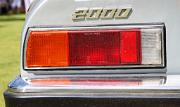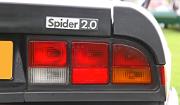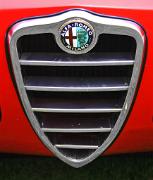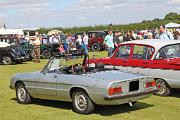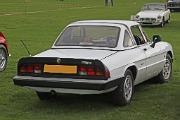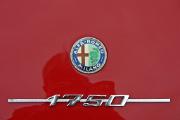Alfa Romeo Duetto
Exhibited at the 1966 Geneva Salon, the Alfa Romeo Spider Veloce was launched with a 1,570cc Giulia engine. Franco Martinengo designed the car and Battista Pininfarina signed it off, his last design. The car was named 'Duetto' after a competition was held to find a name, but it was also known as the 'Osso di Seppia' (round tail). In 1967 the 1750 Spider Veloce replaced the 1600 Duetto, identical apart from the engine. 1970 saw the arrival of the Series II Spider Veloce with 'Coda Tronca', and elongated Kamm Tail. There were 1300 and 1600 'Junior' versions sold in Italy to qualify for lower taxes. In 1971 a 1962cc engine was given to create 2000 Spider Veloce. Federal safety regulations imposed back rubber bumpers on the car in 1983. A further restyle was made in 1990, and the Spider Veloce sold until its replacement arrived in 1994.
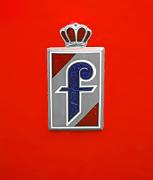
aa Alfa Romeo 1750 1968 Spider Veloce badgepf
Carozzeria Pininfarina on the wing of a Alfa Romeo 1750 1968 Spider Veloce. The last car signed off by Battista Pininfarina
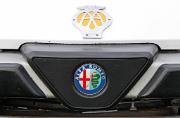
ab Alfa Romeo Spider 2-0 1989 grille
Alfa Romeo Spider 2.0 1989. Introduced in 1983 the Series III 'Duetto' and gained a new 'grille' which found the Scudetto shield reduced to a small trapezoid of black plastic.
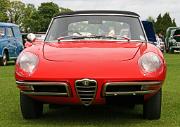
ac Alfa Romeo 1750 1968 Spider Veloce head
Alfa Romeo 1750 1968 Spider Veloce. Launched in 1966 the Spider Veloce was given a 1,570cc dohc 4-cylinder engine. In 1968 this was upgraded to the 1,779cc dohc engine, and a 1,290cc engine was offered in the Spider 1300 Junior. Finally a 1,962cc 2000 Spider Veloce replaced the 1750 Spider Veloce
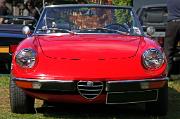
ac Alfa Romeo 1750i 1970 Spider Veloce head
Alfa Romeo 1750i 1970 Spider Veloce. In 1970 the Spider was revised with new bumper and grille. Headlamp covers were deleted for North American cars, and later for other markets. North American cars had mechanical fuel Injection ('Iniezione') provided by Società Pompe Iniezione Cassani & Affini (SPICA), which was supposed to provide the same performance and meet Federal regulations.
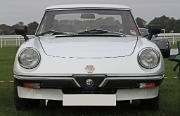
ac Alfa Romeo Spider 2-0 1989 head
Alfa Romeo Spider 2.0 1989. Introduced in 1983 the Series III version of the 'Duetto' gained a new nose. It was powered by a 1,962cc dohc engine which had carbs in Europe and electronic fuel injection for North America.
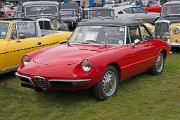
Alfa Romeo 1300 1968 Spider Junior front
Alfa Romeo 1300 1968 Spider Junior. For Tax purposes, a 1290cc 89bhp version of the 'Duetto' was introduced in 1968 with unfaired headlamps, non-opening quarterlights and hubcaps. In 1972 a 1570cc Spider 1600 Junior was also available.
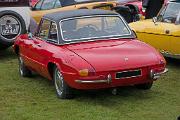
Alfa Romeo 1300 1968 Spider Junior rear
Alfa Romeo 1300 1968 Spider Junior. Introduced in 1968 the tax-dodging 1290cc Spider Junior only had it's 'boat-tail' for 2years before all the Duetto cars got the cut-off tail.
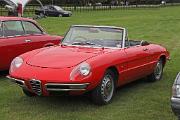
Alfa Romeo 1600 1967 Spider Veloce frontr
Alfa Romeo 1600 1967 Spider Veloce. Built on the Tipo 105 base, the Duetto was designed by Franco Martinengo under Battista Pininfarina at Pininfarina. Power came from a 106bhp 1,570cc twin cam 4-cylinder engine already used in the Tipo 105 Giulia. The name 'Duetto' was chosen in a competition but could not be given to the car because of copyright reasons.
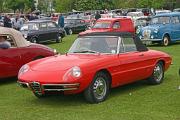
Alfa Romeo 1750 1968 Spider Veloce frontr
Alfa Romeo 1750 1968 Spider Veloce. In 1968 the Spider Veloce replace the Duetto and was given a 1,779cc dohc engine
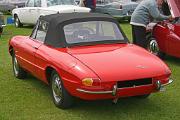
Alfa Romeo 1750 1968 Spider Veloce rearr
Alfa Romeo 1750 1968 Spider Veloce. Designed under Franco Martinengo at Carozzeria Pininfarina the Spider was given a 'Osso di seppia' tail which evolved from two Superflow exhibition cars
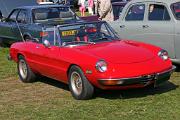
Alfa Romeo 1750i 1970 Spider Veloce front
Alfa Romeo 1750i 1970 Spider Veloce. In 1970 the Spider was revised with new bumper and grille and a capacious Kamm Tail. North American cars had mechanical fuel Injection ('Iniezione') provided by Società Pompe Iniezione Cassani & Affini (SPICA), which was supposed to provide the same performance and meet Federal regulations.
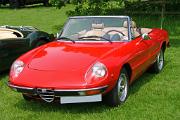
Alfa Romeo 2000 1980 Spider Veloce front
Alfa Romeo 2000 1980 Spider Veloce. The 2000 Spider Veloce appeared in 1971 when the 1,962cc dohc 4-cylinder engine replace the 1750. The Series II from 1970 had revised styling front and rear
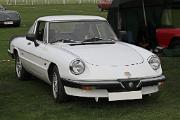
Alfa Romeo Spider 2-0 1989 front
Alfa Romeo Spider 2.0 1989. Introduced in 1983 the Series III version of the 'Duetto' gained a new nose. Carozzeria Pininfarina continued to build the Series III Spider in Torino.
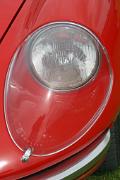
l Alfa Romeo 1750 1968 Spider Veloce lampf
Alfa Romeo 1750 1968 Spider Veloce. Headlamp. Series I cars had plexiglass covers on the headlamps

s Alfa Romeo 2000 1980 Spider Veloce side
Alfa Romeo 2000 1980 Spider Veloce. The Series II from 1970 had revised styling front and finally lost its 'Osso di seppia' (cuttlefish) tail and was given a new 'Coda Tronca' (Kamm Tail) by Carozzeria Pininfarina.
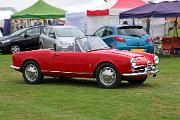
Alfa Romeo Giulia 1600 1964 Spider frontr
Alfa Romeo Giulia 1600 1964 Spider . Introduced in 1962 and essentially updated versions of the outgoing Giulietta with the 1,570cc engine
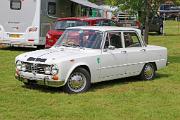
Alfa Romeo Giulia Super 1970 frontw
Alfa Romeo Giulia Super 1970. Introduced at the 1965 Geneva Salon the Giulia Super was a road-going version of the racing TI, with two double-choke Weber 40DCOE carburettors on the 1,570cc engine, and 4-wheel discs and a serpent crest of the Sforza family on the C-pillar
All images and content of this site is the copyright of Simon GP Geoghegan

